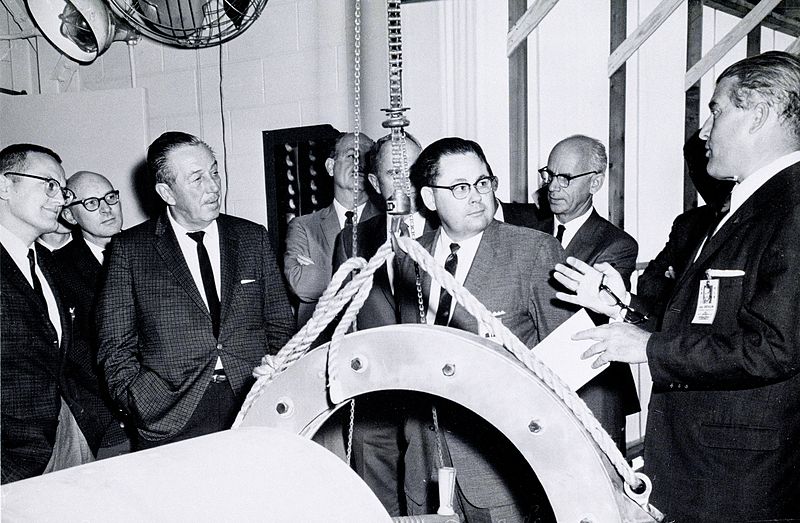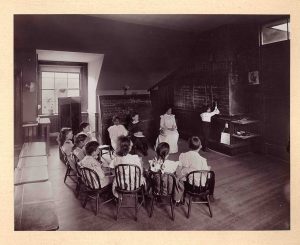Families throughout the United States faced hard times during the late-1930s. People were still recovering from the effects of the Great Depression, unfulfilled promises from President Roosevelt’s New Deal, and unemployment.1 During these financially troubled times, two dreamers, brothers Roy and Walt Disney, were on a mission to continue to produce quality animation on a fixed budget. After Fantasia‘s disappointing initial grossing, Disney Animation Studios’ debt was edging toward $3 million, which led to Walt Disney cutting all of his animators’ salaries. Although Roy Disney believed that this would undermine everything the two had built, he realized the only alternative was to sell their films through a franchise or file for bankruptcy, and so he agreed to the arrangement, unaware of the wrath that would follow.2

Tensions rose as animators also noticed a change in Walt Disney’s attitude toward them. The once cheerful man who was full of magic soon lost that touch, becoming distant to the people around him. Walt began to take all the credit for the animations that were being produced, and his employees soon realized that their pay was much lower than Disney’s salary. His ‘in-betweeners’ and clean up men were making $20 at the most, while his animators, ranging from amateurs to professionals, made between $75 and $300 weekly. Walt brought home a salary five times what his highest paid animators were bringing home.3
These pay disparities led his beloved animators to walk out on the company. On May 28, 1941, employees were greeted by hundreds of their coworkers waving signs preventing them from entering the studio. Although the exact number of employees who went on strike differs between sources, it is estimated that roughly one-third of the 1200 employees went out that morning. For the first few days of the strike, employees exchanged jokes and banter. The animators held up picket signs with clever illustrations that depicted their true emotions. One that struck deep to the studio was a picture of Walt Disney’s face in a cartoon style with crossed eyes and the caption “I can’t see why they’re unhappy.”4 Walt refused to give in to the demands of his employees, because he did not feel that they needed the increase in pay. This firm stance left the strike to go on for five whole weeks, tearing apart the company’s unity. This tension led Walt to leave for South America to take some time away from work, while he let go almost half of his team. After a bank representative for the company stepped in to review the case, the studio was sustained in favor of the animators leading to the dispute being settled. Though a treacherous three and a half months had passed, work finally resumed at the studio in Burbank, California with 694 employees on September 16, 1941.5

Just as everything seemed to be falling into place, the unimaginable happened. On December 7, 1941, the Japanese Navy Air service struck down on the United States naval base in Pearl Harbor sending the United States into World War II. Panic set in for the animators again as the cost of the films being produced during this time put a damper on the company’s overall budget.6 During this time, Walt and his company were sought out to produce cartoons for the armed services as morale builders. They also used half of the animation studio to house antiaircraft troops that were fighting during World War II. Although the company seemed to be taking on too much, this engagement would inspire Walt to create a few propaganda short films and war posters of his own that would speak to the people of the United States. Of all of the animation produced during the war, the most notable piece was Der Fuehrer’s Face, an animated short film in which Donald Duck dreams he is working in a German factory, all while ridiculing Adolf Hitler. The combination of housing troops in the studio, producing short films that expressed the idea of America’s freedom, and the efforts to inspire those fighting for the United States broaden the brand as a whole, showing every single American know what the Disney company stood for at the time.7
Though Walt himself did not find very creative success regarding his work toward the government propaganda animation and posters, it paid off very well for the company, raising its reputation and generating profits. The animation studio’s contributions to America during the World War II brought smiles with their comedic satire to families struggling to find hope as their loved were out serving their country. Soon after, they produced notable works such as Bambi (1942), Song of the South (1946), and Cinderella (1950), with Cinderella generating enough gross profit to pull the company out of debt and further establish their brand. Had both the strike and Walt lending a hand during the war not happened to the Walt Disney Animation Studios, Walt and Roy Disney may not have been able to sufficiently pay their ‘on the edge of leaving the company’ employers and the bills that came with owning the animation studio. The studio itself could have shut down permanently, never transforming from two passionate brothers’ project to a multi-billion dollar brand that brings magic fans and families all across the globe.
- The Hutchinson Unabridged Encyclopedia with Atlas and Weather Guide, 2018, s.v. “The USA in the 1930s.” ↵
- Neal Gabler, Walt Disney: The Triumph of the American Imagination (New York: Knopf, 2006), 350-351. ↵
- Neal Gabler, Walt Disney: The Triumph of the American Imagination (New York: Knopf, 2006), 355. ↵
- Steven Watts, The Magic Kingdom: Walt Disney and the American Way of Life (Boston: Houghton Mifflin, 1997), 209 ↵
- Neal Gabler, Walt Disney: The Triumph of the American Imagination (New York: Knopf, 2006), 367-371 ↵
- Barry Keith Grant, “Walt Disney Company,” Schirmer Encyclopedia of Film, Vol. 4, (New York: Schirmer Reference, 2007), 331-336. ↵
- Paul Lagasse, “Walt Disney,” The Columbia Encyclopedia, 8th ed. (Columbia: Columbia University Press, 2018) ↵



94 comments
Luis Magana
Growing up watching Disney, it had a big impact on my life. The thought of it that it could of shut down makes me sad because maybe my childhood would of been different and people would not of been able to enjoy the simple joy in watching Disney. I always had a good impression of Walt Disney and thought he was a good man, but i didn’t know he mistreated his employees. Disney has a certain face people see as just being happy, but in reality there are so many more things going on.
Daniela Duran
I really enjoyed reading this article! It is not usual to read about the business-side of the Disney Company, and it was actually very interesting and impressive. I had never thought that a company as big would traverse such hard economic situations, but after reading this, I kind of got reminded that the Disney Company is just a business, like any other. I am impressed by Walt Disney’s’ ability to create hope amongst Americans during the time of war, because it shows that he had a meaningful purpose for his career: use his talents to make others happier. Very good article!
Sienna Guerra
Walt Disney always seemed like such a magical person and hard working man, but after reading the article, its very saddening to see his selfish side personality wise. He was so unfair to his animators and people who worked for them by underpaying them which is wrong. Also knowing at one point Disney struggled and almost filed for bankruptcy is a crushing thought to read to my heart of a child. I applaud those who still work at Disney and may be going through a similar situation but still work everyday to keep a smile on a child;s face to live the Disney dream.
Jose Sanchez
It is crazy to even fathom the idea that Disney could have shut down and not provided so much joy. It was alarming to see Walt mistreat his employees. I always thought he was a good guy. His work in creating films to boost morale deserve credit, but some of his portrayals of our enemies during World War 2, specifically the Japanese, are overtly racist.
Ariana Melendez
I enjoyed reading this article due to its general idea that at times hardships can lead to incredible success. This article did a good job of highlighting the main issues that the Walt Disney company had to deal with. It is also important to know that this all happened during a hard time for America since they were going through the Great Depression and then joined World War II.
Sofia Andrade
This article provided new information I did not know about before. I had no idea that Disney was in debt and could have possibly come to an end. I learned that because of the time period Disney produced a short film ridiculing Hitler. This article made me realize that most of the movies we know today could have not existed. How different would the world be without Disney?
Pedro Gonzalez Aboyte
I never knew this side of Walt Disney and I never knew he was struggling so much he considered filing for bankruptcy. It seems like a selfish way to act when you are under pressure the way he was. I don’t think it was right to lower pay for his animators and take home lots more money than they did. This article shows that even through rough patches we must always try to succeed. Although he did not go about it the ideal way, he ended up keeping Disney alive. Without all of this, we would not have the amazing and entertaining Disney Company many have come to know and love.
Kacey Diaz
It’s crazy to even imagine that one of the world’s biggest companies was on the verge of going bankrupt and almost never coming back from all their upsets. There were several interesting things about this article such as the strikes, Walt Disney having a brother (I never knew that), and the WWII propaganda that came from Disney.
Luisa Ortiz
WOW! first, I did not have any remote idea that Walt Disney had a brother, for me it was always him! Reading about his brother’s roll in the company was very new to me! Walt Disney really overcomes a lot of hard situations, there is no doubt for me that Walt is a true leader, an innovator and of course an artist, I’m glad everything works out great at the end!
Janelle Larios
Walt Disney always seemed like such a magical person and hard working man, but after reading the article, its very apparent how unrealistic that mindset was. Disney seemed so cold hearted and disinterested with the lives and well being of his employees. I twas very shocking to see how selfish he actually was. I also watched the Donald Duck animation clip and it was crazy to see that they created so many short films to boost morale i guess, but its propaganda in it of itself and it was just very shocking over all.